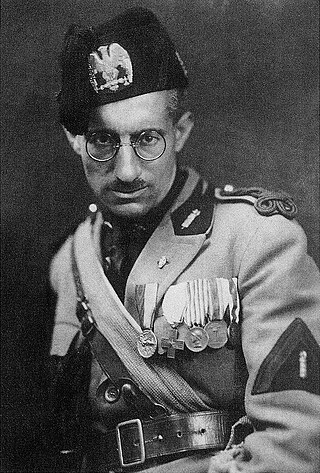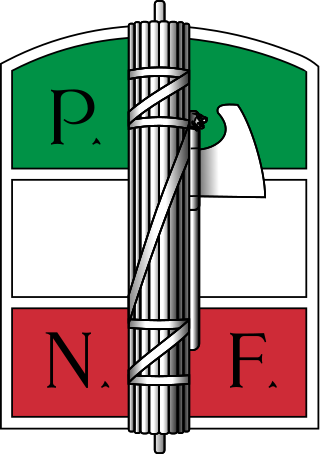Related Research Articles

Michele Bianchi was an Italian revolutionary syndicalist leader who took a position in the Unione Italiana del Lavoro (UIL). He was among the founding members of the Fascist movement. He was widely seen as the dominant leader of the leftist, syndicalist wing of the National Fascist Party. He took an active role in the "interventionist left" where he "espoused an alliance between nationalism and syndicalism." He was one of the most influential politicians of the regime before his succumbing to tuberculosis in 1930. He was also one of the grand architects behind the "Great List" which secured the parliamentary majority in favor of the fascists.
Fascio is an Italian word literally meaning "a bundle" or "a sheaf", and figuratively "league", and which was used in the late 19th century to refer to political groups of many different orientations. A number of nationalist fasci later evolved into the 20th century Fasci movement, which became known as fascism.

Opera Nazionale Balilla (ONB) was an Italian Fascist youth organization functioning between 1926 and 1937, when it was absorbed into the Gioventù Italiana del Littorio (GIL), a youth section of the National Fascist Party.

Italian fascism, also known as classical fascism or simply fascism, is the original fascist ideology as developed in Italy by Giovanni Gentile and Benito Mussolini. The ideology is associated with a series of two political parties led by Benito Mussolini: the National Fascist Party (PNF), which ruled the Kingdom of Italy from 1922 until 1943, and the Republican Fascist Party (PFR) that ruled the Italian Social Republic from 1943 to 1945. Italian fascism is also associated with the post-war Italian Social Movement (MSI) and subsequent Italian neo-fascist movements.

The National Fascist Party was a political party in Italy, created by Benito Mussolini as the political expression of Italian fascism and as a reorganisation of the previous Italian Fasces of Combat. The party ruled the Kingdom of Italy from 1922 when Fascists took power with the March on Rome until the fall of the Fascist regime in 1943, when Mussolini was deposed by the Grand Council of Fascism. It was succeeded, in the territories under the control of the Italian Social Republic, by the Republican Fascist Party, ultimately dissolved at the end of World War II.

Chamber of Fasces and Corporations was the lower house of the legislature of the Kingdom of Italy from 23 March 1939 to 5 August 1943, during the height of the regime of Benito Mussolini's National Fascist Party.
Women in Italy refers to females who are from Italy. The legal and social status of Italian women has undergone rapid transformations and changes during the past decades. This includes family laws, the enactment of anti-discrimination measures, and reforms to the penal code.
This is a list of words, terms, concepts, and slogans in the Italian language and Latin language which were specifically used in Fascist Italian monarchy and Italian Social Republic.
Feminism in Italy originated during the Italian renaissance period, beginning in the late 13th century. Italian writers such as Moderata Fonte, Lucrezia Marinella, and others developed the theoretical ideas behind gender equality. In contrast to feminist movements in France and United Kingdom, early women's rights advocates in Italy emphasized women's education and improvement in social conditions.
The Pact of Pacification or Pacification Pact was a peace agreement officially signed by Benito Mussolini, who would later become dictator of Italy, and other leaders of the Fasci with the Italian Socialist Party (PSI) and the General Confederation of Labor (CGL) in Rome on August 2 or 3, 1921. The Pact called for “immediate action to put an end to the threats, assaults, reprisals, acts of vengeance, and personal violence of any description,” by either side for the “mutual respect” of “all economic organizations.” The Italian Futurists, Syndicalists and others favored Mussolini’s peace pact as an attempt at “reconciliation with the Socialists.” Others saw it as a means to form a “grand coalition of new mass parties” to “overthrow the liberal systems,” via parliament or civil society.
Massaie Rurali was an Italian organisation for peasant women within the Italian Fascist Party (PNF). MR was founded in 1933 and disbanded in 1945. It was the largest women's organisation in Fascist Italy and one of the largest organisations, with more than three million members in 1943.
Sezione Operaie e Lavoranti a Domicilio (SOLD) ('Section for Female Laborers and Home-workers') was an Italian organisation for urban working-class women within the Italian Fascist Party (PNF). SOLD was founded in 1937 and disbanded in 1945.
Angiola Moretti, was an Italian politician of the National Fascist Party (PNF).
Elisa Majer Rizzioli (1880-1930), was an Italian politician of the National Fascist Party (PNF).
Laura Marani Argnani (1865-1955), was an Italian politician of the National Fascist Party (PNF).
Giuditta "Itta" Stelluti Scala Frascara was an Italian politician of the National Fascist Party (PNF).
Clara Franceschini, was an Italian politician of the National Fascist Party (PNF).
Baroness Teresita Menzinger Ruata, was an Italian politician of the National Fascist Party (PNF).
Wanda Bruschi Gorjux (1889-1976), was an Italian politician of the National Fascist Party (PNF).

Olga Medici del Vascello (1882-1966), was an Italian politician of the National Fascist Party (PNF).
References
- ↑ Peasant Women and Politics in Fascist Italy: The Massaie Rurali , Perry Willson, London, Routledge, 2002, ISBN 0415291712
- ↑ Christine Fauré: Political and Historical Encyclopedia of Women
- ↑ Jennifer Linda Monti: The Contrasting Image of Italian Women Under Fascism in the 1930s
- ↑ de Grazia, V. (1992). How Fascism Ruled Women: Italy, 1922–1945. USA: University of California Press.
- ↑ de Grazia, V. (1992). How Fascism Ruled Women: Italy, 1922–1945. USA: University of California Press.
- ↑ de Grazia, V. (1992). How Fascism Ruled Women: Italy, 1922–1945. USA: University of California Press.
- ↑ de Grazia, V. (1992). How Fascism Ruled Women: Italy, 1922–1945. USA: University of California Press.